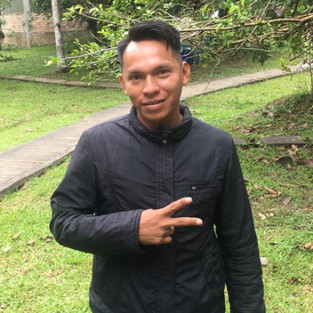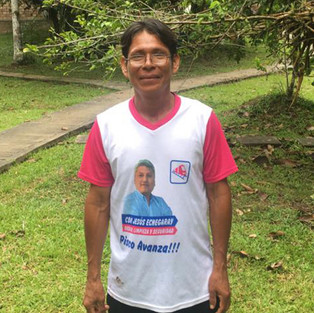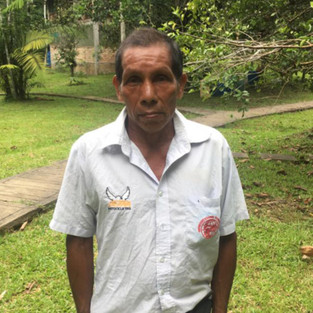No Good Deed goes Unpunished - Community Health Worker Training goes on Despite Challenges!
- Devon Graham-Project Amazonas

- Sep 23, 2020
- 12 min read
Updated: Oct 12, 2020
Gary Selnow is a good person. His boss is Finnegan, a golden retriever, so you know he's a really nice guy. Golden retrievers have good judgement. So I was all ears when Gary contacted me a few months ago about a new comprehensive community health worker (CHW) program that Wired International had developed and had successfully tested in Kenya. The program includes 120+ hours of training time covering a wide range of topics from anatomy and physiology to contagious and non-contagious diseases, vector, food and water-borne diseases, use of medications, and the critical role that CHWs can play in safe-guarding health in their communities through education, surveillance for health issues, and reporting to health authorities.
Participants in the training sessions receive a tablet with the modules downloaded on them, so they can follow along with the instructors, and also review the material, graphics and quizzes and study on their own time. The contents of the course were rigorously prepared by medical and public health experts, meet all of the World Health Organization standards for training CHWs and participants who pass the final exam receive a certificate, and their certification can be renewed each year by taking an on-line refresher course. Wired International is also continually expanding the number of Spanish-language modules available on specific topics - from asthma to zika - all of which can be downloaded for free. Gary wanted to know if Project Amazonas would be interested in running a training session in the Amazon, and, by the way, Wired International did have some grant money to help cover expenses. I quickly said yes. Had Gary's boss been a shitzu or pomeranian, I might have hesitated, but I've also known Gary for a number of years, and Wired International created a unique and innovative mobile patient database for use on our medical service expeditions. The credibility was there.

Community health workers and trainers on the first morning of the workshop at Madre Selva Biological Station. Workshop leaders Roy Ocmin Saavedra (DDS) and Diana Alvarez Casternoque (RN) are at left (photo by Fernando Rios)
The first challenge for Wired International was to get the training modules translated into Spanish, a not-inconsequential task involving several thousand screens of content. Bilingual medical students at Western University of Health Sciences in California came to the rescue, and the work was well underway when the Covid-19 shutdown came along. The translators kept plugging away at it, but there were inevitable delays, as well as the addition of a Covid-19 module. By mid-summer, the translation was essentially done and the material ready for final formatting.
By July, most countries around the world were in varying degrees of lockdown or denial, and a Wired International training session in southern India was successfully transitioned from in-person to on-line only, demonstrating the robustness of the program. Peru, in the meantime, was moving beyond 100+ days of lockdown, although some local travel restrictions were being relaxed. Restrictions on gatherings were still being strictly enforced, however. We considered postponing the planned August training session until 2021, but decided that this was the moment when Amazon communities most needed to have informed and competent health workers. We would move ahead with the program, even if it was entirely on-line.
It took longer than anticipated to format all the new Spanish-language modules for tablet use (Android), but by late-August we received the word that they were good to go. Here in Miami I was easily able to download the the app that powers everything (HealthMap) and the bundled modules to my cell phone, and with a bit of coaching from Gary, downloaded the Mac versions to my Mac. In Iquitos, our logistics person - Guillermo Guerra - searched all the stores and was able to find enough Lenovo tablets of the same model. They cost double what they would in the USA, but there was no way to take or send tablets down. We set a start date of 14 September for the workshop, and we were good to go - or so we thought. There were a few things we hadn't counted on though, and Covid-19 had a lot to do with all of them.
With the necessary tablets in hand, Guillermo tried to download the HealthMap app android modules using wifi at the house we maintain in Iquitos. No success. The same was true for downloading to his PC. No reason for alarm - internet is reliably slow in Iquitos at any time, you just have to pick and choose the time for moving any heavy files. How about 6 AM, before business use starts up. Still no luck. OK - start at 2 AM and go till 10 AM. A wee bit of success, some modules would download, but then they wouldn't open past the first page, or the program would promptly shut down when you clicked on anything. Guillermo took a couple of tablets to the most reliable and fastest cyber-cafe in town and tried again there. Similar results. He contacted a tech guy in the Peruvian Navy and left tablets and a laptop with him in the hopes that the dedicated Navy wifi would do the trick. No joy. Some modules would download and actually open - but not in a consistent fashion between tablets and/or laptop.
In California, where Wired International is based, Gary Selnow consulted with his developers and they tested everything out again. On their end everything worked perfectly notwithstanding the forest fire apocalypse outside their windows. They were getting frustrated, Guillermo was frustrated, and the workshop start date was fast approaching. We managed to set up a couple of Zoom meetings with California, Miami, and Iquitos, but weren't able to solve the technical issues even with screen share and tablets being held in front of laptop cameras. Gary and his crew broke down the bundled modules and posted them to their download page one at a time - 26 downloads, instead of 3. Here in Miami, I could download most of the individual modules in less than a minute. In Iquitos, Guillermo could download a single module in 1 to 2 hours, but less than half of them would open. It was becoming clear that slow internet was a major part of the problem.

High noon at the Selnow residence in California on 10 September (photo by Gary Selnow)
There have never been access speeds anywhere close to 3G in Iquitos to start with, but this was closer to 512 KB speed! Rumors were that a transmission tower was down, but with the suspension of all in-person classes at universities and schools in the country, hundreds of thousands of students are now trying to do their courses on line (which also explains the shortage of tablets). Add on millions of Peruvians staying in contact with family and friends via Facebook or other social media rather than in person, and business and professional meetings moving on-line, and the bandwidth has just been overwhelmed. Unable to afford laptops or tablets, and/or entirely without internet access, rural and poor urban students are losing an entire year of classes.
We had originally thought about bringing the workshop participants to Iquitos for a hybrid in-person & on-line workshop, but strict Covid-19 restrictions on gatherings nixed that. Currently only 6 people are allowed to meet together in a private residence, and they must wear masks. Public gatherings are banned entirely, and the entire country is locked down every Sunday - no exceptions. Who would have anticipated that church services and raucous parties would be lumped together as infectious disease super-spreader venues? Bringing rural community health workers to Iquitos for a 3-week course also raised the real risk that they might be infected with coronavirus and then take it back to their communities at the end of the course.
Our Madre Selva Biological Station on the Orosa River looked like the optimal venue. The majority of participants were from nearby communities, so that greatly reduced travel times for most, we had plenty of housing capacity (so no hotel bills) and having our cooks prepare meals for the group was substantially cheaper than giving participants a stipend to get their own meals in Iquitos (eating out 3X daily would also be increasing their risk of infection). Additionally, with no international travel taking place, the field station had no users, and had been sitting empty since mid-March.

Home communities of the community health workers attending the workshop. Most are from the Orosa River area (close to Madre Selva Biological Station)
Getting in touch with the CHWs in the rural communities was an issue. There is no cellular service (at all) in most of the communities that were to be represented. With a rapid expansion of cell phone use and coverage in urban and peri-urban areas over the past 10 years, the rural satellite phone system that once allowed communication has been abandoned by the government, and over the past couple of years, community after community has told me that their satellite phone no longer functions. Some communities have even tried to reactivate their short-wave radio systems that predated the satellite phones, but there are no more short-wave operators in Iquitos or other urban areas to take the calls. We sent some fuel by public speedboat to the Madre Selva Biological Station caretaker, Julio Sinojara, and asked him to notify the CHWs in person. In a small canoe with a dragontail motor, he was able to contact most of the CHWs, but extreme low water and rapids blocked access to two of the most remote communities. The word was out, however, and everyone knew to arrive on 14 September. There was no turning back now - people were on the move.
Workshop participants and leaders by row (from left to right)
Row 1: Susy Andy Torres Cahuachi (San Pedro, Rio Orosa); Rufino Falcon Shuña (Santo Tomas, Rio Orosa); Wilder Cahuachi Ruiz (Yanayacu, Rio Apayacu)
Row 2: Moises Amasifuen Braga (San Pedro, Rio Orosa); Rosalio Najar Saavedra (Santa Rosa, Rio Orosa); Roy Ocmin Saavedra-DDS, workshop co-leader (Iquitos)
Row 3: Milca Rucoba Olimar (Puerto Miguel, Rio Yarapa); Milagros del Pilar Valcarcel Hernandez (Belen, Rio Itaya); Maximo Vilchez Falcon (Nuevo Israel, Rio Orosa)
Row 4: James Mozombite Sanchez (Nuevo Israel, Rio Orosa); Lino Linares Torres (Nuevo Libertad de Paucarillo, Quebrada Matahuayo); Luis Peña Cahuachi (Santa Ursula, Rio Orosa)
Row 5: Juan Yuyarima Jaramillo (San Jose, Rio Ucayali); Jairo Villacorta Vasquez (Puerto Fujimori, Rio Orosa); Ewis Fasanando Diaz (Apayacu, Rio Apayacu)
Row 6: Diana llamaria Alvarez Casternoque-RN, workshop co-leader (Iquitos); Artemio Santana (Santa Ursula, Rio Orosa)
No photo available: Erica Estefani Peña Rucoba (Puerto Miguel, Rio Yarapa); Jairo Alonzo Tapayuri, Ahuanari (Yanashi, Rio Arambassa); Helmer Pano Cahuamari (Comandancia, Rio Orosa)
As 14 September approached, everyone was antsy. Guillermo was still having limited success with downloading the modules, and our general manager, Fernando Rios, was worried about river levels, and daily calling the town of Huanta, at the mouth of the Orosa River, to see if the river was passable. Much as I hate giving business to Walmart, I ordered an identical Lenovo tablet (to the ones we had in Peru) to see if I could successfully download the modules here in Miami. Walmart was the only vender that guaranteed next day delivery, some of the others promised delivery by mid-October, not very useful!
The Lenovo arrived on 11 September, and despite not having a first-grader around to show me how to use it, and after running out to buy SD micro memory cards (who knew a tablet didn't arrive with memory?), I was able to successfully download and test all the modules. The problem was definitely not with the tablets, the problem was the slow internet in Iquitos. Using the SD cards, I tried moving files between Mac, PC, and the tablet to see if there might be a solution there, but the three formats were not compatible, as Guillermo was able to confirm when a DHL package with two flash drives with files from my Mac made it to him on 15 September. Sixty dollars for a padded envelope to arrive in 6 days might seem a bit steep, but a card that I sent by first class mail over a month ago has still not arrived in Iquitos.
We were back at square one. About half of the modules were functional on the laptop in Peru, and a few modules were functional on three of the tablets. With 22 tablets in hand, 26 modules to download, and an average of 1.5 hours to download a single module (successfully OR unsuccessfully), that was going to be a minimum of 858 hours or about thirty-six 24-hour days to get all of the tablets loaded. This obviously was not going to work.

Transferring from a larger boat on the Amazon to one small enough to make it through shallow channels (photos by Luis Guerra)

The 14th of September arrived, and one of our wooden boats with food and fuels, chef Charly Taminche, steward and camp manager Lider Nolorbe, and Mr. Fix-Anything, Segundo Rios, headed downriver (eastward) at 4 AM to get an advance start on things. Fernando Rios had already confirmed that the Orosa River was not passable at its mouth, so logistics were going to be interesting. First by boat from Iquitos to a point on the Amazon close to Yanashi, then transfer to very small boat to get to Yanashi, then overland on a crumbling "concrete" trail by motokar to the Orosa River, and then by small boat onward to Madre Selva Biological Station. At 10 AM, Fernando headed out with speedboat from Iquitos with workshop leaders dentist Roy Ocmin, and nurse Diana Alvarez, along with several participants from areas further west of Iquitos. Also on board were two projectors, the laptop with some functional modules, and the three tablets that had some functionality. At high water, we can do the trip in 3.5 hours, this time it took 8.5 hours to arrive.

Pushing and pulling boats through shallow water on the way from the Amazon to Yanashi (photos by Luis Guerra)



The following morning, with all the participants on hand, the workshop began, using the projector to present the modules so that everyone could see and follow along. Meanwhile the Wired International techs were still at work. We collectively agreed that getting all the modules functional on a laptop was the first priority. The workshop would continue with what modules they had on hand, but it was critical to get the rest of the modules to Madre Selva so that they could be used in the logical order in which they were prepared. The techs took each of the modules and put them in zip files and sent Guillermo and I the link for downloading them. I had no problem rapidly downloading and unzipping (or "extracting") them. We waited anxiously for news from Iquitos. Finally Guillermo responded - he had successfully downloaded, extracted, and verified that all 26 modules were functional on his personal laptop. This was a big step forward, and we immediately sent him out to purchase a new laptop to load everything on. That was also done successfully, and while I write this (10:40 AM on 23 September) that laptop is on a boat on the way to Madre Selva - for the first time, the workshop leaders will have all the material on hand.

Introductions and the first training CHW training session at Madre Selva Biological Station (photos by Luis Guerra)

Meanwhile, Guillermo has been in touch with contacts in Lima, the capital of Peru, and they have been able to successfully download the HealthMap app and training modules to cell phones there, so we'll probably have Guillermo fly to Lima with the tablets, download the material there, and return to Iquitos. Flights are sparse, but prices are cheap, and this way we can get the tablets into the hands of the workshop participants with 10 days of workshop remaining. That will be an important factor in letting them individually review and study the material.

First group breakfast at Madre Selva - chicken/noodle/yuca soup - a typical breakfast for the region (photo by Luis Guerra)
I woke up Thursday 24 September to find the beautiful image below in my inbox. Great news! Guillermo had successfully downloaded the modules to two tablets overnight after switching cell coverage providers (go Bitel!). The process took about 50 minutes for each tablet (the single "no" was due to clicking too quickly on the button for the succeeding module, and was easily corrected).

Over the next few days, Guillermo was able to download the modules to the remaining tablets, and as of Wednesday 30 September, they were in the hands of the CHW training session participants. The other good news? River levels were rising again, so getting everyone back to their home communities when the workshop was over wasn't such a drag.
The Wired International training course ends with a 100 question on-line qualifying exam with questions selected from those that are present in every module, so there was still another challenge to overcome. The government clinic in Yanashi not too far away has internet, but it is reserved for clinic use, and the bandwidth was way too narrow to allow more than one person at a time to take the 2.5 hour exam. That wasn't going to be an option. We made the decision to bring the participants back to Iquitos, housing and feeding them on our Esperanza riverboat to avoid having additional hotel and restaurant expenses.
Using several cell phones to serve as mobile hotspots for the tablets, we thought that everything was a go. We even purchased an additional cell phone with a Bitel chip thinking that that would give additional insurance that everything would work. The exam URL was programmed to open at 8 AM and close at 10:30 AM. As bad luck would have it, the Iquitos internet demons decided that it would be a good time to wreak havoc. We started by trying to have 4 participants link to each phone. When that didn't work, we tried just 2 participants per phone, then just one. But when the test URL wouldn't even open on the cell phones, we had to acknowledge defeat. Gary jumped on the computer and reformatted the exam into a PDF which we were able to get to Guillermo in Iquitos. He ran out and made photocopies, and several hours after the initial planned start time, we were able to administer the exam.

Community health workers take the qualifying exam aboard the Esperanza riverboat. They spent the previous three weeks learning together (photo by Fernando Rios)
Meanwhile, our manager Fernando Rios, was able to purchase basic medical supplies to send with the community health workers back to their home communities. The prices on just about every item had risen relative to what we had paid back in February, in some cases doubling or tripling, but at least we were able to send something to each community.

Community health workers with basic medical supplies for their communities - ready to return home (photo by Fernando Rios)
The following morning, the participants all returned to their home communities, and we are already planning on how to do one or more training sessions in 2021, but taking into account all the lessons that we learned - mostly the hard way! Giving community health workers in rural Peru this kind of training fills a critical gap in a health care system where the closest doctor might be hours or days away, and where communications are often non-existent.
So Gary, give Finnegan a super nice doggie treat, and a big THANK YOU to yourself and to the Wired International techs from all the workshop participants! If you would like to support future workshops in Peru, please do contact either ourselves or Wired International.





































Comments